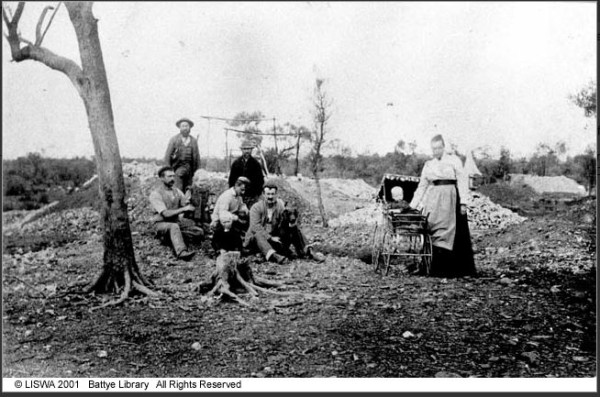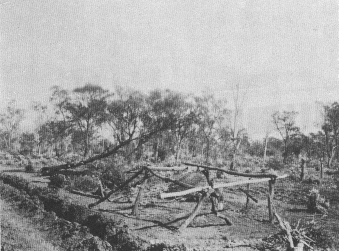Region: Goldfields-Esperance
Coordinates: -30.24271, 120.954051
Directions: Shire Coolgardie
Located 86 kms NW of Kalgoorlie and 25 kms NW of Ora Banda
Reserve Number R8052
Number of Graves: 17
First Burial: James McCormick aged 19, a miner who died of fever 22 Feb 1895
Last Burial: John Dillon aged 75 who died of senile decay 30 Oct 1925
History
Name
Siberia was the name given to the find by Billy Frost in 1893, but in 1898 the town was gazetted as Waverley after a mine nearby. After the Postmaster raised concerns that there were other places called Waverley, the name was officially changed back to Siberia in 1914. It is thought the name came from an ironic sign that read “To Siberia or Hell” which was cut into a tree on the track at the time of the ill-fated gold rush to discourage miners from the journey.
Discovery
Ernest Giles is believed to have travelled through the area in 1875. Gold was first discovered here by Billy Frost and Bob Bonner in October 1893. Frost rode into Coolgardie with 50 oz. of gold and was mobbed by miners wanting to know where the new find was. But they had to wait until next morning when Frost had registered his claim with the Warden. He named his claim Siberia, probably ironically, and warned men not to go as there was no water. However, the prospect of a rich gold find led many to ignore the warnings and a “stampede” began. Most were not seasoned bushmen and many travelled with as little as one waterbag. They assumed that wagons would be following with water supplies, but the teamsters found the sand tracks impossible to traverse, as they bogged in the sand.
Fred Renou, Superintendent of Water Supplies in Coolgardie, sent his young assistant, W. Lock Armitage, to investigate. His heroic efforts saved many men. He reached the 25 Mile Well (Morrowong Well), the last known water source before the long track to Siberia. He came upon a scene of frantic confusion, with 600 men with wagons and horses, fighting over the water at the well. The well-keeper whose job was to charge for and ration the water, had been thrust aside, with threats of violence. Much of the water had been spilt by men perishing of thirst fighting over the water. At the bottom of the well were two men fighting over the trickle left. The well was dry. Armitage pulled out a gun and brought the situation to order. He placed armed guards at the well, which gradually replenished so the men could drink by the day's end.
For two nights, Armitage lit a beacon on a large granite hill nearby, and thirty men saw this and dragged themselves into the camp almost dead. They brought with them horrific stories of men going mad from thirst and dying, having discarded their clothing, tools and swags. Many had not been able to find the gold field.
An Afghan water carter named Ameer arrived at 25 Mile, with eight camels and two employees, Pindar and Jamelkin. The camels were packed with tanks of water and Armitage asked for volunteers to accompany the Afghans and their camels north. Only two out of the 600 men came forward; Lewis Davis, and William Lobban. Armitage, the Afghans, and these two men headed north on a rescue mission. It took them a week to cover the 80 miles, as each day they had to detour following tracks of men who had wandered off course. One was followed for miles, along a trail of discarded clothes, and dragged footmarks, until lost on an ironstone ridge. Another was found naked under a bush, mouth swollen from thirst and unable to move.
They eventually got to Siberia Soak and found it had no water, and 140 desperate men. They all made the slow march back to 25 Mile Well, with Armitage bringing up the rear picking up stragglers.
Meanwhile, without any knowledge of what was going on at 25 Mile Well, Renou sent three wagons of water, which proceeded north from 25 Mile and met up with the weary army of men marching back.
No-one knows how many men died out there. At least 37 men were said to be missing but many did find their way back. For years after various prospectors would stumble across bleached bones of one of the victims, and they would be buried in lonely bush graves. At the 25 Mile there were said to have been at least 12 graves by 1896.
Early History
The gold found here was mainly alluvial and miners used dry-blowing methods to extract it. Some of the mines to the north and west of the townsite were known as Nuggetty Gully, Pearling Grounds and Deep Lead. Others to the north-east were Majestic, Invincible and Noah’s Ark Gully. Several deeper shafts were dug but with limited success. The State Battery with five heads was constructed two miles from the town on the road to Callion about 1904. A report by Montgomery, the State Mining Engineer, in 1909 on the state of mining in the area concluded that, although there had been some rich patches, generally this was a low-grade field, supporting only a few miners.
In 1906, the townsite boasted two hotels, a store, the post office and a Mechanics Institute.
Statistics
|
AGES AT DEATH |
|||||
|
0 – 1 |
1 |
20 – 29 |
1 |
60 – 69 |
5 |
|
2 – 5 |
0 |
30 – 39 |
3 |
70 – 79 |
2 |
|
6 – 9 |
0 |
40 – 49 |
0 |
80 + |
0 |
|
10 – 19 |
1 |
50 – 59 |
3 |
Unknown |
1 |
|
OCCUPATIONS |
|||||
|
Child |
1 |
Dryblower |
1 |
Prospector |
3 |
|
Condenser Owner |
1 |
Miner |
7 |
Unknown |
1 |
|
CAUSE OF DEATH |
|||||||
|
Asthma |
1 |
Heart attack/condition |
3 |
Murdered by spearing |
1 |
Senile Decay |
1 |
|
Exposure |
1 |
Inflammation of bowel |
1 |
Natural causes |
1 |
Suicide |
2 |
|
Fever |
1 |
Jaundice |
1 |
Premature birth |
1 |
Unknown |
3 |

A family at Reward Gold Mine about 1900. Photo from State Library WA

Lonely grave on the Siberia Track
Map Waverley townsite
Near the remains of the Reward Hotel at Siberia stands a bougainvillea bush which was planted by Mabel Kirkham in memory of her baby son who died only hours after his birth in 1902. She reportedly said that “this bush shall never die for my heart lies beneath it.” He was the fourth of her six children, with all the others surviving to adulthood. The father of the child, Jimmy Kirkham, was the publican at the Reward Hotel at the time and known as a good sportsman and community leader. They remained in Siberia until at least 1916, later returning to their home state of South Australia.
For 122 years, passers-by, mine workers and locals have stopped by to water the plant and maintain the memory of this tiny baby. It has become a must-see attraction of a Goldfields tour, with a metal box containing a visitors’ book and many mementos left by visitors.
